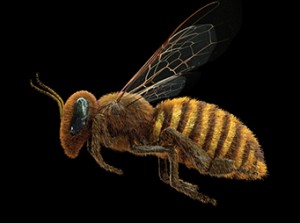Things That Bug You in the Field
Click here to read the complete article
164 – September 2019
I was sitting around a few days ago with some non-hunting pals of mine and one asked me what I found most dangerous or annoying when I was hunting or training the dog. Bears, he suggested? Nope. Haven’t seen a bear since I quit hunting ruffed grouse in the northwoods 30 years ago. Snakes, maybe? Not in my part of the country. All the snakes here are benign. Mud? Nah, that’s just something you deal with. “Well, what then,” he asked? The answer is simple. Bugs! There are things out there whose thirst for human blood transcends mine for fine wine and medium rare Chateaubriand or Maine lobster.
Let’s begin with that creature that’s one of the many spawn of Satan, the deer fly. Deer fly? Balderdash! Human and dog flies is what they really are. Their only purpose in life is to bite and the only way to stop it from biting is to kill it. They are impervious to any repellent known to man. Hitting a deer fly that’s drilling into any area of your head hard enough to kill it will likely also cause a concussion. The same is true for the dogs. Smack a deer fly on their muzzle hard enough to kill it and you may very well loosen the dog’s teeth.
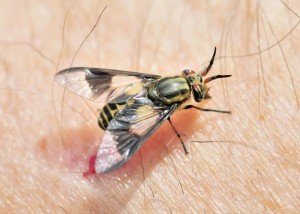 They attack viciously and leave a welt the size of Mount McKinley. They’re also at their most barbarous when you are least able to fight them off such as when you have a bunch of ducks or pheasants in one hand and your shotgun in the other. When that happens, it’s a given that you’re going to be enveloped in a cloud of hissing deer flies. I have nothing good to say about deer flies. Even in my benign moments I can’t picture a family of deer flies sitting around the fireplace together nor can I imagine a mama deer fly cuddling her baby flies. There is no such thing as reformation for deer flies gone bad because they have no qualities worth redemption. They’re all bad. They’re born with the same psychological makeup as a combination of Count Dracula and the Marquis de Sade. To say I hate deer flies is to say that the bloody battle for the Tarawa Atoll in WWII was just a minor tiff.
They attack viciously and leave a welt the size of Mount McKinley. They’re also at their most barbarous when you are least able to fight them off such as when you have a bunch of ducks or pheasants in one hand and your shotgun in the other. When that happens, it’s a given that you’re going to be enveloped in a cloud of hissing deer flies. I have nothing good to say about deer flies. Even in my benign moments I can’t picture a family of deer flies sitting around the fireplace together nor can I imagine a mama deer fly cuddling her baby flies. There is no such thing as reformation for deer flies gone bad because they have no qualities worth redemption. They’re all bad. They’re born with the same psychological makeup as a combination of Count Dracula and the Marquis de Sade. To say I hate deer flies is to say that the bloody battle for the Tarawa Atoll in WWII was just a minor tiff.
As long as the subject is “animal” insects, a word about horseflies is in order. Bigger than a C-5 Galaxy and noisy enough to cause hearing loss, they have a bite like a stallion’s, or maybe more accurately, a mare’s since the female is the one that bites which may be why they’re called horseflies. Her bite is painful because she actually cuts a hole in your skin and then laps up the blood that comes out. It’s not easy to catch these sadistic savages because they are quite agile for something so big and frequently escape before you feel the pain of their bite. The life-span of a horsefly is short but they’re determined to make the most of it. They’re not easily deterred from attacking and they will even chase their intended victims. Since most repellents are not effective with horseflies, my advice is aim true and and beat the daylights out of them. It also helps to wear light colored clothing as they are attracted to dark colors.
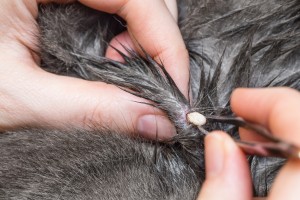 Another swarm of creatures that qualify as the sons and daughters of the devil are mosquitos. Not only are they our most familiar and noxious insect, they are omnipresent and the high pitched whine of one loose in the bedroom has kept many a human’s nerves on edge through the entire night. They are also responsible for the spread of such “delights” as malaria, West Nile virus, several types of encephalitis, yellow fever and dengue, in addition to being the host for heartworms in our dogs. In fact, my dog, an otherwise tough retriever who will break ice in pursuit of a downed bird, becomes a whimpering, whining, for-Godsakes-let-me-back-into-the-house-before-I-need-a-blood-transfusion guy if he happens to be out in the dog yard during the height of the mosquito season at dusk when the evil little fiends are most active.
Another swarm of creatures that qualify as the sons and daughters of the devil are mosquitos. Not only are they our most familiar and noxious insect, they are omnipresent and the high pitched whine of one loose in the bedroom has kept many a human’s nerves on edge through the entire night. They are also responsible for the spread of such “delights” as malaria, West Nile virus, several types of encephalitis, yellow fever and dengue, in addition to being the host for heartworms in our dogs. In fact, my dog, an otherwise tough retriever who will break ice in pursuit of a downed bird, becomes a whimpering, whining, for-Godsakes-let-me-back-into-the-house-before-I-need-a-blood-transfusion guy if he happens to be out in the dog yard during the height of the mosquito season at dusk when the evil little fiends are most active.
In some of the areas where I hunt, the mosquitos are nearly the size of a B-52. In fact, a friend of mine who is in the National Guard contends that the other day, at the Army post not far from my house, one landed on the airstrip and the ground crew had it half refueled before they realized it had the wrong tail markings. Moose and mature whitetails in my state are in mortal danger of being sucked dry of blood by the hoards of mosquitoes. While the swarms of these pests are annoying enough in the early duck season before the frost, what’s really infuriating are those lone strays that manage to survive the first or even second frost; and just about the time you and your hunting partners are remarking about how nice it finally is to be on the marsh without having to apply DEET with a trowel, one of the little she-devils will zoom in on your face, the only patch of exposed skin anywhere on your body, for one last blood meal before she heads off to hibernation.
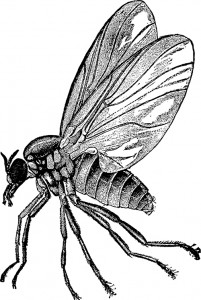 Another creature that must trace its beginnings from Hell’s Pit is the black fly also known as Buffalo Gnats and no-see-ums. It doesn’t matter what you call them, although most of what I call them is unprintable, they are a bête noire to any activity in the field and that includes dog training during the height of the black fly season. While only about six species of black flies bite, that’s more than enough. The others just swarm around your and the dog’s heads getting in eyes, mouth, nose and ears because they are attracted to the carbon dioxide we and the dogs exhale causing extreme annoyance to both the canines and humans. The ones that do bite can create swelling the size of a golf ball and cause “black fly fever,” a lovely little malady marked by headaches, nausea, fever and swollen lymph nodes. They also leave red welts about the size of a nickel on the dog’s underbelly areas where his fur is thinner.
Another creature that must trace its beginnings from Hell’s Pit is the black fly also known as Buffalo Gnats and no-see-ums. It doesn’t matter what you call them, although most of what I call them is unprintable, they are a bête noire to any activity in the field and that includes dog training during the height of the black fly season. While only about six species of black flies bite, that’s more than enough. The others just swarm around your and the dog’s heads getting in eyes, mouth, nose and ears because they are attracted to the carbon dioxide we and the dogs exhale causing extreme annoyance to both the canines and humans. The ones that do bite can create swelling the size of a golf ball and cause “black fly fever,” a lovely little malady marked by headaches, nausea, fever and swollen lymph nodes. They also leave red welts about the size of a nickel on the dog’s underbelly areas where his fur is thinner.
That brings us to chiggers, a microdot of pure unvarnished itch. To a chigger, a human or a dog is the most lavish buffet imaginable. If you look at a chigger under a microscope, it looks like a creature from a horror movie although it’s likely that even with the finest, most diabolical minds in Hollywood creating a monster to resemble a chigger, the results would be Shirley Temple singing “On the Good Ship Lollipop” compared to a real life chigger leering up at you through the lens. Unlike deer flies, chiggers don’t just suck your blood and then leave you with an itchy welt. They become unwelcome guests like those irritating folks who don’t know when to go home and who stick around until they’ve eaten everything edible in sight. Chiggers dig into your and the dog’s hide dissolving cells and creating an itch so bad it will make you want to run naked into a prickly ash thicket or roll in a patch of Canada thistle to relieve it. What’s more, chiggers only seem to bite in areas you can’t scratch, at least not in polite company.
 Ticks are another plague from Hell. A sure sign of spring, along with robins scooping up the last of the fermented apples beneath the flowering crab trees, crocus and daffodils starting to peek up in the garden, and the drumming of a lovelorn ruffed grouse or the crowing of an equally neglected pheasant rooster, is the patter of little feet on your neck or crawling up the inside of your pants leg. You know immediately when you feel this crawly sensation that your hemoglobin level is about to take a hit or you’ll be left with an itch unsatisfied by scratching if you don’t immediately apprehend the crawler. That’s if all that results from a tick bite is an insatiable itch and not one of the numerous tick-borne rickettsial diseases that affect humans and dogs alike including anaplasmosis, lyme disease, ehrlichiosis and Rocky Mountain spotted fever.
Ticks are another plague from Hell. A sure sign of spring, along with robins scooping up the last of the fermented apples beneath the flowering crab trees, crocus and daffodils starting to peek up in the garden, and the drumming of a lovelorn ruffed grouse or the crowing of an equally neglected pheasant rooster, is the patter of little feet on your neck or crawling up the inside of your pants leg. You know immediately when you feel this crawly sensation that your hemoglobin level is about to take a hit or you’ll be left with an itch unsatisfied by scratching if you don’t immediately apprehend the crawler. That’s if all that results from a tick bite is an insatiable itch and not one of the numerous tick-borne rickettsial diseases that affect humans and dogs alike including anaplasmosis, lyme disease, ehrlichiosis and Rocky Mountain spotted fever.
Ticks are roughly as easy to back out of your skin as it is to back a trailer for the first time without any previous instructions and a good spotter. However, that’s mere child’s play compared to the job of removing ticks from a dog that won’t hold still, insists on personally checking out every tick you remove, and thinks it is helping by licking. In those circumstances it’s difficult to determine which is worse, the dog or the tick. Fortunately for the dogs, most ticks can be eliminated by tick collars or anti-tick medications. Sadly, we humans don’t have such convenient tick fighters. We’re stuck with either DEET or spraying clothing with permethrin–the latter of which you absolutely don’t want to get on your skin.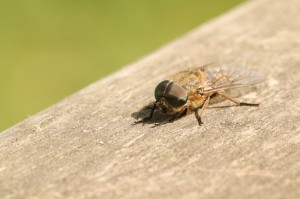
Finally there are the hymenoptera–the bee, wasp, hornet, yellow jacket crew. While none of these could be considered pleasant companions, the worst are the yellow jackets. They are as short tempered as a bear with a sore paw and aggressive as a great white shark that smells blood in the water. Even if you are minding your own business and nowhere near their nest, yellow jackets don’t care. They’ll sting you just for the pure hell of it. They have the rare ability to both sting and bite or so an entomologist once told me. Indeed, he said, they often bite your flesh to get a better grip as they drill their stingers into your skin and they don’t lose their stinger when they do which means they can leave a fiery trail of pain all the way up your pants leg. A friend of mine once compared being stung by a yellow jacket to backing into a hot curling iron. He said that having experienced both, he was in a position to accurately judge the pain. If you have the misfortune to bite down on a yellow jacket bent on sharing your meatloaf sandwich, it’s like biting into a lit cigar. If you are attacked by these hostile little devils when you are out training, since negotiation is not an option, the only prudent course of action for both you and the dog is to run like hell to get away from them. Don’t try to fight them off because that only makes them angrier. The treatment for both you and the dog, unless one of you has an allergy to bee/wasp/hornet stings–in which case the immediate treatment is epinephrine and a call to your vet or a physician depending upon who is showing an allergic reaction–is cold compresses and Benadryl. Baking soda paste and unfiltered vinegar are also helpful in relieving the pain.
With luck, this has answered the question of what I consider most dangerous/annoying in the field. It’s important to remember that nature works in mysterious ways and that everything has a reason for being, even deer flies, horseflies, mosquitos, black flies, ticks and yellow jackets. After all, if it hadn’t been for these minions of Mephistopheles, probably none of us would ever have learned how to cuss.
Click here to read the complete article
164 – September 2019
Short URL: http://caninechronicle.com/?p=172409
Comments are closed











